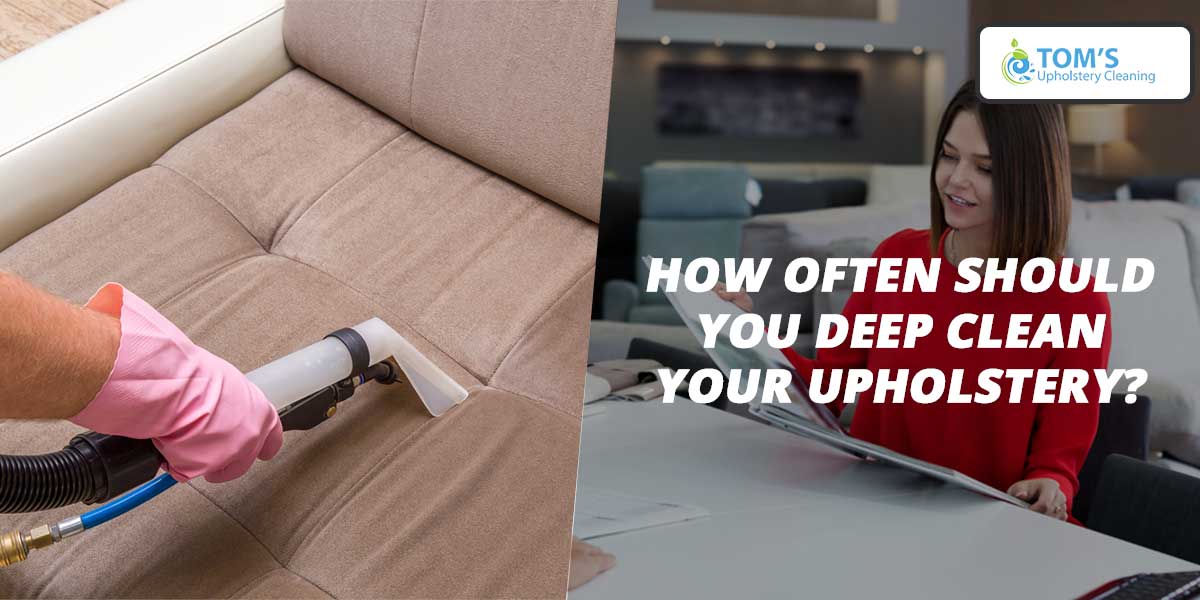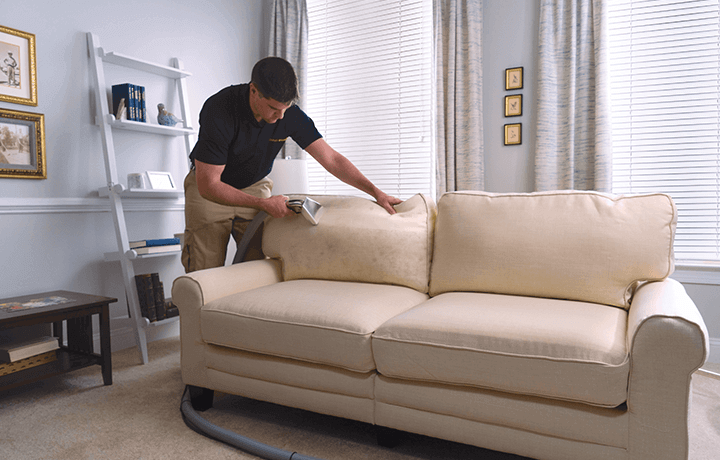You should clean your sofa every 3 to 6 months. Frequent usage or having pets may require more regular cleaning.
Keeping a sofa clean extends its lifespan and ensures it remains a comfortable and hygienic centerpiece in your living area. With daily wear, the accumulation of dust, crumbs, pet hair, and possible spills can make your couch look and feel less than inviting.
Professional cleaning is a good idea once a year, but interim maintenance is crucial for preserving the fabric’s quality and color. Employing a vacuum cleaner with an upholstery attachment helps in the routine removal of surface dirt and debris. Timely spot cleaning immediately after spills can prevent stubborn stains, making your sofa welcoming and well-maintained. Regular cleaning not only improves the appearance of your furniture but also contributes to a healthier indoor environment.

Credit: www.housedigest.com
Understanding Sofa Maintenance
Maintaining a clean sofa is crucial for a tidy home. Regular cleaning schedules preserve the lifespan and appearance of the sofa. It also promotes a healthier environment. Quick action on spills prevents stains and damage to the material.
The Importance Of Regular Cleaning
Regular sofa maintenance ensures your seating remains comfortable and visually appealing. Dirt and grime can break down fabric fibers, while dust mites and allergens potentially impact health. Developing a routine cleaning strategy sustains the quality and comfort of the sofa.
- Extends sofa’s lifespan
- Prevents buildup of dirt and odors
- Keeps fabric colors bright
- Mitigates allergens and pests
Factors Affecting Sofa Cleaning Frequency
Several factors determine how often a sofa needs cleaning. Consider usage, material, and household circumstances.
| Factor | Cleaning Impact |
|---|---|
| Usage | High use requires more frequent cleaning. |
| Material | Delicate fabrics may need gentler, more regular cleaning. |
| Pets | Fur and accidents necessitate additional cleanings. |
| Children | Spills and stains are more common, increasing cleaning sessions. |
| Allergies | Regular cleaning is vital to remove allergens. |
Asses these factors to create a tailored cleaning plan that works best for your lifestyle and sofa maintenance needs.
Types Of Sofas And Their Cleaning Needs
Keeping your sofa clean ensures it stays attractive and lasts longer. Different sofas have unique needs based on their materials. This guide dives into the specifics for leather, fabric, and synthetic sofas.
Leather Sofas: Preserving Quality
Leather sofas bring luxury to your living space. To maintain their rich texture and appearance, these are the steps:
- Dust weekly with a soft cloth or vacuum with a brush attachment.
- Wipe spills immediately to prevent stains.
- Use a leather conditioner every 6-12 months to keep the leather soft.
Avoid direct sunlight and sharp objects to prevent fading and scratches.
Fabric Sofas: Handling Delicate Materials
Fabric sofas feel cozy but require gentle care. Follow these tips:
- Vacuum regularly to remove dust and crumbs.
- Spot-clean stains using a suitable upholstery cleaner.
- Professionally clean every 12-18 months for a deeper clean.
Check the manufacturer’s label for specific care instructions.
Synthetic Sofas: Ease Of Cleaning
Synthetic sofas are family-friendly and easier to maintain. Keep them looking new:
- Wipe with a damp cloth for regular maintenance.
- Use mild detergent for stain removal.
- Machine-washable covers are a bonus if available.
They resist stains and odors well, making them ideal for daily use.
Signs Your Sofa Needs Cleaning
Your sofa is a centerpiece in your home, hosting family time, movie nights, and social gatherings. But it doubles as a collector of daily life’s debris. Recognizing when your sofa requires a thorough clean is key to maintaining its beauty and extending its life.
Here are telltale signs:
Spotting Stains And Spills
A drop here, a spill there – your sofa can boast a timeline of household activities. Here’s a fast guide:
- Beverage stains: Coffee rings or juice marks are common.
- Food spills: Crumbs or sauce splotches can lead to sticky spots.
- Spot cleaning only goes so far; a deep clean might be due.
Noticing Odors And Allergens
Sniff out the truth:
- Musty smells suggest trapped moisture or mildew.
- Pet odors can linger beneath the surface.
- Allergic reactions such as sneezing could point to dust mite accumulations.
Don’t ignore these invisible culprits. Act fast to freshen up your sofa.
Visual Assessment: When A Sofa Looks Dirty
An easy visual check can reveal a lot:
| Aspect | Indication |
|---|---|
| Faded fabric | Wear and tear from daily use |
| Discolored armrests | Oil, sweat, dirt buildup |
| General dullness | Time for a deep clean |
Take a moment to inspect: Does your sofa shout for help?
The Influence Of Lifestyle On Cleaning Schedules
The Influence of Lifestyle on Cleaning Schedules varies widely from household to household. Your unique lifestyle commands its own set of rules when it comes to maintaining a clean sofa. Factors such as having pets, children, or a knack for entertaining guests will determine the frequency of sofa cleaning. Tailoring your cleaning routine to these elements ensures a fresh, inviting living space for everyone to enjoy.
Pets And Their Impact On Cleanliness
Owning pets often means dealing with extra fur, dander, and the occasional accident. These factors contribute to a need for more frequent cleanings. Pet owners should consider:
- Vacuuming weekly to remove pet hair and dander.
- Using a lint roller for spot cleaning fur-covered areas.
- Monthly deep cleans to address any pet-related odors or stains.
Children: Addressing Frequent Spills And Messes
Kids are experts at creating messes, often resulting in frequent spills and stains on your couch. To protect your sofa from permanent damage:
- Spot clean spills immediately to prevent stains.
- Implement weekly vacuuming to get rid of crumbs and debris.
- Embrace monthly steam cleaning to sanitize and refresh your sofa.
Entertaining: More Guests, More Cleaning
Hosting parties or having guests over increases the need for a clean sofa. With more use comes more maintenance. Keep your sofa ready for company by:
- Performing a quick vacuum before and after guests arrive.
- Spot cleaning any spills immediately after events.
- Scheduling a deep clean after a significant gathering.
Seasonal Sofa Cleaning Considerations
Your sofa is not just a piece of furniture but a repository of memories and comfort. Yet, it can also harbor dust and allergens.
Let’s explore how the changing seasons affect your sofa cleaning routine.
Spring Cleaning: A Fresh Start
Spring brings renewal, and your sofa deserves the same. Shake off the winter blues with a thorough sofa clean-up.
- Vacuum crevices to remove crumbs and pet hair.
- Spot clean fabric for spills from cozy winter nights.
- Consider steam cleaning to refresh sofas for the new season.
Fall Preparations: Getting Ready For Indoor Living
With fall, indoor living spaces become more central to family life. Prepare your sofa.
- Assess your sofa for summer wear and tear.
- Apply fabric protector to guard against fall spills.
- Deep clean for a cozy and inviting atmosphere.
Holiday Cleans: Pre And Post-guest Arrival
Holidays mean guests and gatherings. Keep your sofa guest-ready.
| Before Guests Arrive | After Guests Depart |
|---|---|
|
|
Professional Vs. Diy Sofa Cleaning
Deciding between professional or DIY sofa cleaning is not always easy. Your cozy couch can trap dirt, dust, and grime. Knowing the right cleaning method ensures a fresh and hygienic sitting area. Learn whether to call a pro or tackle the task yourself.
When To Call In The Professionals
Deep stains, delicate fabrics, and persistent odors often require professional help. A pro cleaner uses special tools to deep clean. Look for signs your sofa needs a pro:
- Stubborn stains: Difficult to remove spills may need special treatment.
- Sensitive material: Materials like suede or leather are best left to experts.
- Bad smell: Smells that linger suggest a deep clean is necessary.
- Overall refresh: A yearly deep clean maintains your sofa’s look and feel.
Diy Solutions: Tips And Tricks
Simple messes and maintenance can be effectively handled with DIY methods. Try these easy tips to keep your sofa clean:
- Vacuum often: Regular vacuuming prevents dirt from settling in.
- Spot clean: Quick action on spills avoids hard-to-clean stains.
- Use mild cleaners: Gentle solutions protect fabric integrity.
Homemade mixtures like vinegar, baking soda, and water can treat minor spots. Always test a small, hidden sofa part before a full application.
| DIY Cleaning Agent | Best for |
|---|---|
| Baking Soda and Vinegar | Odor Removal |
| Soap and Water | Light Stains |
| Rubbing Alcohol | Grease Spots |
Always stay informed on your sofa’s material guidelines when opting for a DIY clean. Regular care keeps your sofa inviting year-round!
Sofa Cleaning Techniques
Caring for your sofa is like looking after your favorite outfit. It needs to stay fresh and look its best. Knowing the right cleaning techniques is key. Let’s explore how to clean your sofa effectively, keeping it cozy and inviting.
Vacuuming: The First Step
A clean sofa starts with removing dust and dirt. Vacuuming is the first step to a spotless couch. Use the upholstery attachment on your vacuum cleaner. Ensure to reach the corners and crevices where crumbs like to hide. Regular vacuuming every week helps maintain sofa hygiene.
Spot Cleaning: Tackling Stains Head-on
Accidents happen, and stains can appear. Spot cleaning is your immediate action plan. Always blot a stain, never rub, to avoid spreading it. Use a trusted upholstery cleaner or a homemade solution of water and gentle soap. Test the cleaner on a hidden part of the sofa first to ensure it’s safe for your fabric.
Deep Cleaning Methods
For a thorough refresh, consider deep cleaning your sofa every few months. This process can involve a variety of methods:
- Steam cleaning uses hot water vapor to lift dirt without harsh chemicals.
- Foam cleaning involves applying a foaming detergent and vacuuming it up along with the grime.
- Dry cleaning is an option for delicate fabrics that shouldn’t get wet.
Always check the manufacturer’s instructions before choosing your deep cleaning method. Remember, some sofas may require professional services for best results.

Credit: www.merrymaids.com
The Role Of Sofa Covers And Throws
Sofa covers and throws are not just decorative; they serve a vital purpose. These accessories act as a first line of defense against wear, spills, and stains that would otherwise shorten your sofa’s lifespan. Understanding how to leverage these items can significantly reduce the frequency of deep cleans. Let’s explore the protective measures you can take and why consistency in cleaning these covers is crucial.
Protective Measures To Extend Cleanliness
Using sofa covers and throws strategically is a smart move. These layers shield your sofa from daily hazards. Think of kids with sticky fingers or a pet that loves curling up on the couch. Sofa covers are especially effective for high-traffic furniture, while throws can be perfect for occasional naps or movie nights.
- Choose machine-washable materials to simplify cleaning.
- Opt for snug-fitting covers to prevent slippage and gaps.
- Select colors and patterns that hide minor soiling.
Cleaning And Changing Covers Regularly
Maintaining a clean sofa is easier with routine cover changes. Regular washing keeps the fabric fresh and prevents deep-set stains. Here’s a straightforward plan to tackle this task:
| Frequency | Action |
|---|---|
| Weekly | Spot clean minor spills and marks. |
| Bi-weekly | Shake out and air throws. |
| Monthly | Wash sofa covers, following fabric care instructions. |
Remember, the frequent renewal of these covers sustains a clean environment. Not only does this keep your sofa looking good, but it also ensures hygiene for all who use it.
Integrating Sofa Cleaning Into Your Routine
Keeping your sofa clean not only maintains its appearance but also prolongs its life. Integrating sofa cleaning into your routine ensures comfort, hygiene, and a welcoming environment for your home. With simple steps, seamlessly blend this task into your daily life.
Creating A Cleaning Schedule
To maintain a fresh sofa, consistency is key. Design a cleaning schedule that fits your routine. This prevents buildup of dirt and makes cleaning less daunting.
| Frequency | Task |
|---|---|
| Weekly | Vacuuming and spot cleaning |
| Monthly | Deep cleaning with upholstery cleaner |
| Bi-annually | Professional cleaning or steam cleaning |
Incorporating Cleaning Into Daily Habits
Combine sofa cleaning with everyday activities. This makes it part of your routine without extra effort. Here are easy practices to adopt:
- TV Time: Fluff and straighten pillows during commercials.
- Evening Routine: Remove any items from the sofa every night.
- Morning Setup: Spend a minute to tidy up the sofa area.
Remember, regular care keeps your sofa inviting and extends its life. By incorporating these habits, sofa cleaning becomes a simple part of your everyday life.
Common Mistakes To Avoid In Sofa Cleaning
Keeping your sofa clean is not just about regular vacuuming. It’s also about knowing the right cleaning methods to avoid damage. Here are some common blunders you’ll want to sidestep to maintain your sofa’s allure.
Overuse Of Water And Chemicals
A wet sofa can turn into a breeding ground for mold. Be careful not to soak your sofa during the cleaning process. Aim for a light mist of cleaner rather than a soaking. Over-saturating your sofa not only prolongs drying time but can also damage the upholstery.
Harsh chemicals can discolor and weaken the fabric. Always opt for gentle, upholstery-friendly cleaners. When cleaning, test any product on a hidden area first. This will ensure it won’t harm the fabric or cause colors to bleed.
Neglecting The Sofa’s Material Guidelines
Different materials require specific care strategies. Always check the manufacturer’s instructions before starting to clean. Leather sofas need a different treatment than fabric ones. Some materials may even demand professional care.
Use cleaning agents designed for your sofa’s material to avoid harm. Below is a brief guide to help you distinguish which cleaners suit various sofa types:
| Sofa Material | Suggested Cleaner |
|---|---|
| Leather | Specialized Leather Conditioner |
| Fabric | Mild Upholstery Shampoo |
| Velvet | Dry Clean only |
- Do not use wax on fabric sofas. It causes stains.
- Never apply bleach to colored materials. It fades the colors.
For optimal results, tailor your approach to your sofa’s unique material. Ignoring these guidelines not only risks damage but also diminishes your sofa’s lifespan.
The Long-term Benefits Of Keeping A Clean Sofa
Caring for your sofa is more than just a chore—it’s an investment in your home’s comfort and health. Ensuring your sofa stays clean can lead to various long-standing benefits. Let’s explore how a regular cleaning routine could impact your furniture’s life and your living space.
Extending The Lifespan Of Your Furniture
Regular sofa cleaning isn’t just about aesthetics; it helps extend your furniture’s life. Dirt and grime can wear down upholstery fibers. Clean sofas resist wear and tear better. It prevents premature aging of your favorite couch. Follow simple maintenance tips to save money on future replacements.
- Vacuum upholstery weekly to remove surface dirt.
- Spot clean spills immediately to prevent stains.
- Flip and rotate cushions to ensure even wear.
- Consider professional cleaning once a year for deep refreshment.
Improving Indoor Air Quality And Hygiene
Soft furnishings can trap allergens and pollutants, affecting the air you breathe. Keeping your sofa clean has health-related advantages. These include reducing potential allergens like dust mites, pet dander, and mold. An unsung hero in the quest for a hygienic home is a clean sofa.
- Utilize a vacuum with a HEPA filter for effective allergen removal.
- Opt for fabric-friendly cleaners that sanitize without harmful residues.
- Keep windows open during cleaning to circulate fresh air.

Credit: tomsupholsterycleaning.com.au
Frequently Asked Questions Of How Often Should You Clean Your Sofa
How Can You Tell If A Couch Is Dirty?
Check your couch for visible stains, unpleasant odors, discoloration, and fabric wear. Feel for sticky or rough areas which indicate dirt buildup.
How Often Should I Wash My Couch Cushions?
Wash couch cushions every 3-6 months, or immediately after spills or stains occur. For homes with pets or allergies, consider monthly cleaning. Always follow the manufacturer’s care instructions for the best results.
Is It Important To Clean A Sofa?
Yes, cleaning a sofa is important to remove dust, allergens, and stains, maintaining its appearance and hygiene. Regular cleaning also extends the furniture’s lifespan.
Is It Worth Cleaning A Sofa?
Yes, cleaning a sofa is worth it as it extends its lifespan, maintains hygiene, and improves appearance. Regular cleaning also eradicates allergens and preserves the fabric’s quality.
Conclusion
Maintaining a clean sofa is essential for home comfort and hygiene. Aim for a professional deep clean every 12 to 18 months, coupled with regular dusting and vacuuming. Adopt these practices to extend your sofa’s life and keep your living space fresh.
Remember, a clean couch invites relaxation and peace.

